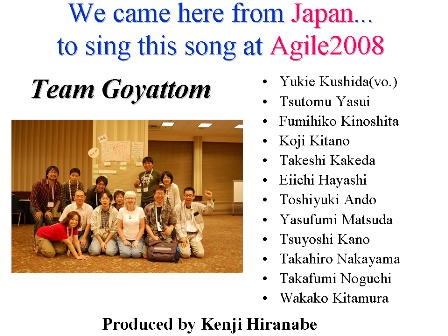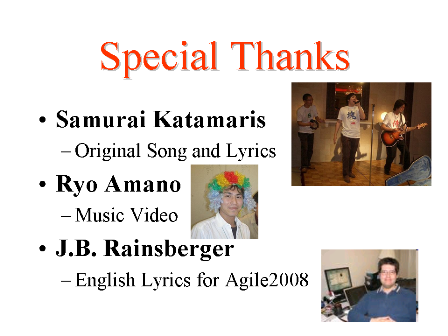|
Categories
Main : Developers Blog :
|

 Syndicate weBLogs
Syndicate weBLogs
|
Most recent entries
2009/07/14
 |
Category: Developers Blog :
Author: midori (9:31 am)
|
Thanks to SEA Tecnologia in Brazil, the Portuguese translation of JUDE/Community 5.5 is now available on JUDE website. Let's enjoy using the Portuguese version of JUDE/Community. 1) Download and install JUDE/Community 5.5. 2) Download a resource file and unzip it. And, save it into JUDE install folder. Please see details in JUDE GUI Localization Introduction of JUDE/Professional, JUDE/Community (Portuguese page) |
|
2009/07/09
 |
Category: Developers Blog :
Author: hiranabe (5:11 pm)
|
While I have been involved in Lean/Agile movement in Japan for these eight years, I have had several chances to talk with Toyota people. Among them, Kuroiwa-san(ex-Toyota manager) who is my Sensei(meaning teacher: although he doesn't like to be called so), one day asked me; Kuroiwa: "Hiranabe-san, what have you learned from TPS(Toyota Production System) ? What is it in one sentence?" Hiranabe: "Flow and Customer pull ?" Kuroiwa: "Maybe." Hiranabe: "Respect for People and Kaizen?" Kuroiwa: "Not bad. But what is it all about ? TPS keeps telling you just one thing. What is it ?" I haven't reached to the answer for two years, but at last, I have... On Feb. 22nd, 2009, Mr. Satoshi Kuroiwa delivered a keynote speech at Agile Japan 2009. he built his career as an IT training manager of Toyota Motor Corporation. In the 1980’s, Toyota Production System was introduced to the factory of NUMMI, a joint venture company founded by Toyota and GM and he had been a manager there. In the factory, more emphasis was put on people and human capabilities than on high technology.  At first, there were more than 200 job skills defined, but he reorganized them into only two rolls --assembly workers and maintenance/service workers-- to develop multi-skilled workers. Thanks to these improvements, the factory that had once been closed was successfully revived. Kuroiwa-san pointed out that excessively divided roles are distributed in the current software industry in a very funny process called "waterfall", and stated that higher efficiency would be achieved if workers gradually expanded their capabilities under shared goals instead of sticking on their segmented skills. He also pointed out that one of the most important Lean concepts was “customer pull”, which means in manufacturing to produce just what customers need. "But what does this mean in software development?" he asked the audience ... "Think for yourself. You are software engineers. In software development, it means that developers should understand the _why_ of the customer needs, instead of the _how_ of realizing the needs using technology." He concluded his speech by emphasizing that “Thinking for yourself in your context” is the heart of Lean, and ranted to the audience that they shouldn’t import anything without questioning why. A lot of software concepts have been imported from abroad and most Japanese software developers just use them without thinking. The problem to solve is always yours and you should think based on your context. See ? The heart of Lean is; "Think for yourself in you context" That was the answer to the first question. As frequently stated, Toyota "makes things" and at the same time, "makes how to make things" i.e. process -- they produce 10,000,000 cars per year(lower this year) and at the same time, adopt 1,000,000 kaizen proposals from company members to improve the process in the factories. But it was not just that. They "make things", "make how to make things" i.e. process, and "make how to make how to make things" i.e. thinking people. Process is meta to product, and people is meta to process, and we are people making the product through the process. TPS is a "Thinking People System". During Toyota plant tours(you can apply via web), I saw a sign board in Motomachi plant where TPS stared, saying "Good Thinking, Good Product." This slogan is commonly seen in Toyota plants.  Here's a photo taken two years ago with Craig and Bas, under the sign of "Good Thinking, Good Product" when they came to Japan and met with Kuroiwa-san. Here's a photo taken two years ago with Craig and Bas, under the sign of "Good Thinking, Good Product" when they came to Japan and met with Kuroiwa-san.++ Another good reference would be; http://www.toyotageorgetown.com/tps.asp |
|
2009/04/15
 |
Category: Developers Blog :
Author: midori (9:10 am)
|
QCon Tokyo was held at Tokyo conference center, Japan on April 9-10, 2009. I have attended several sessions and found some common trend. That is, "Simple is best". In Martin Fowler's keynote speech, he presented Domain Specific Language (DSL). He highlighted readability of code, as role of DSL. It helps business people to understand an application. Also, Rod Johnson, the creator of Spring, in "Spring in a Changing World" stated the failure of old J2EE at first. According to Johnson, J2EE failed because of its complexity. Now developers want simple solutions. and He concluded that "enterprise Java must get simpler". Junzo Hagimoto, a Requirement Development Methodologist, described about how to bring business values into system development. There are misunderstanding and conflict between customers and developers. He recommended to show the whole picture to both and have strategy for generating business value. He said that he was seeking to think and do everything simply. Yukihiro Matsumoto, the creator of Ruby, also introduced Paul Graham's word, "succinctness is power", in his keynote speech "Beautiful Code". He states that code is beautiful and simplicity is also beautiful. As a developer, I believe that seeking simplicity will improve the quality of code and the working environment of developers. Since new technologies are constantly generated and the world becomes increasingly complex, the simplicity will be one of the key factors for success. |
|
2009/04/13
 |
Category: Developers Blog :
Author: midori (4:50 pm)
|
Martin Fowler made a keynote speech at QCon Tokyo on April 9, 2009. He presented an introduction of Domain Specific Language (DSL). As an example, he showed us a statemachine diagram, a class diagram and Java code. It is not a difficult code, but maybe we can not understand it at a glance. At least, we have to read the code to understand. However, it's more readable if you use DSL. He presented several examples such as XML, CSS, regular expressions, Ruby on Rails and DSL. Since these languages have meaning in themselves, they are more readable than other programming languages like Java. We can not develop an application by using regular expressions only, but it's easy to understand when we use it as a part in our coding. DSL also helps business people to understand the application and communicate with programmers. It increases programmer's productivity, too. He says code generation of DSL is "optional". It is sometimes useful and essential, but still optional. He seems that he emphasizes readability of DSL over code generation. In conclusion, he said this speech was an introduction of DSL and we would be able to find more articles in his website. He added he would write about DSL in the future (when he has time!). http://martinfowler.com/bliki/ |
|
2009/02/05
 |
Category: Developers Blog :
Author: Joba (5:55 pm)
|
Hello all, We have released JUDE/professional, Community 5.5 Beta! I would like to show you whats new in 5.5 beta briefly. JUDE/Professional 5.5 Beta - The biggest implement in JUDE/professional in 5.5 Beta would be C++ Support!  - Setting C++ language information to project - Setting C++ language information to project- Type Modifier (such as *, & information) support - C++ Primitive Type Support - C++ Language support for Classes, Attributes and Operations - Export C++ Source code Please read JUDE/C ++ topic for more info. - Font color setting  Finally you can color texts! Finally you can color texts! Font color setting is available for each object name. So you can color text of important objects to make them look stand out or for any purposes. Font color setting is available for each object name. So you can color text of important objects to make them look stand out or for any purposes.- J2SE 5.0, 6.0 tools.jar support for Export HTML Finally JRE 5, 6 tools.jar is supported for HTML export, and the tools.jar of J2SE1.4 is no longer available since ver 5.5b1. - Compare diagrams graphically  Now you can compare two different diagrams graphically, this new feature shows two diagrams side by side and points whats different on the diagram with colored square. It makes it easy to understand the difference between two diagrams visually.  - Export image of UseCase Descriptions and CRUDs - Improvements on StateMachins Diagram, Export Entity Definitions, API...and much more Please see the rest in the Release Note. Try out JUDE/Professional 5.5 Beta, looking forward to your feedback!  Cheers, Satomi |
|
2008/10/31
 |
Category: Developers Blog :
Author: midori (1:45 pm)
|
Thanks to many requests from JUDE users worldwide, we have added UML2.0 support in JUDE/Community 5.4. Now you can draw Composite Structure Diagrams in JUDE/Community5.4 :  And, you can draw Sequence Diagrams by using Combined Fragments, Interaction Use and State Invariant, and so on :  Other UML2.0 elements have been added. The detailed information of UML 2.0 in JUDE is available at : http://jude.change-vision.com/jude-web/product/features.html#uml2 Download JUDE/Community5.4 : https://jude.change-vision.com/jude-web/serviceDownloadLink.do You may also check the new functions in JUDE/Professional 5.4 : https://jude.change-vision.com/jude-web/product/professional.html |
|
2008/10/03
 |
Category: Developers Blog :
Author: midori (4:55 pm)
|
Thanks to SEA Tecnologia in Brazil, the Portuguese translation of JUDE/Community 5.3 is newly added in JUDE website. Let's enjoy using the Portuguese version of JUDE/Community. 1) Download and install JUDE/Community 5.3. 2) Download and set the Portuguese resource file into JUDE. Please see details in JUDE GUI Localization |
|
2008/09/02
 |
Category: Developers Blog :
Author: midori (10:07 am)
|
JUDE API Forum has been opened. This forum is aimed to share JUDE API programs among JUDE users. The following programs are available in the forum: - DB Reverse - CSV Export - Class/ER Diagrams Export - State Transition Table Also, C# reverse program will be released in the next version of JUDE. JUDE API enables you to reference, create and edit JUDE models. (Create and edit functions are supported in JUDE/Professional only.) Let's have a look at JUDE API samples. Your application using JUDE API will be welcomed, too.  |
|
2008/08/15
 |
Category: Developers Blog :
Author: hiranabe (6:35 pm)
|
The biggest event for me was the banquet party. I got 2008 Gordon Pask Award for contribution to Agile community. And I led a group of Japanese to sing the song Dear XP! Thank you very much! (Gordon Pask Award) (Dear XP at the banquet party, Agile2008)
|
|
2008/08/15
 |
Category: Developers Blog :
Author: hiranabe (6:17 pm)
|
Kanban is another emerging topic, I'm catching up with. I met David, Corey, Aaron, and Karl -- "Kanban All Stars" at the conference! This is a photo from workshop led by Karl and Aaron. Corey summirized all the Kanban related sessions in his blog. I think there are two ways to scale out Agile. One is "Tree" type, or Scrum of Scrums type. In this model, strong synchronization of the teams is needed. The other is "River" type, or lean type, where multiple teams work asynchronously using buffers inbetween. In this "river" type, even the concept of iteration is not necessary. (There is other reasons for iterations, but logically no need) Kanban works very well in relatively a stable development, like maintainance phase of products, where team structure or state transition of work items is identified and stable. Here is my observation of Kanban 9 features. Kanban is a balancing tool between continuous flow and reducing WIP. AND, is a visualization tool for Kaizen or process improvement. My infoQ article related to this topic is here.  |
|

















